Unusual things on trees and walls at Berry Head
Everything is shiny and glistening in the woods up to Berry Head. It's been a few months since our last visit to this end of the reserve. In the interim we've become hooked on lichens, finding to our amazement that these miniature, wondrous forms occur just about everywhere, all year round.
It sounds a bit melodramatic to state it's akin to seeing the world through new eyes but that's exactly how it feels: as if there is an enriched perspective on things; a new dimension. Nothing will ever be the same again.
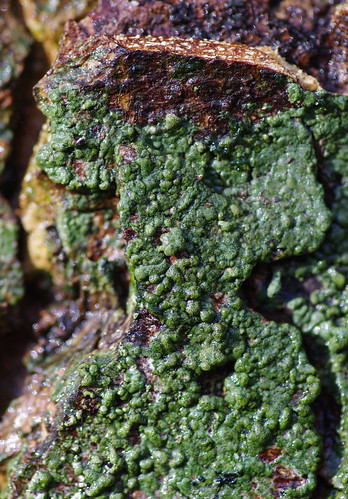
Pertusaria lichen?
A few months ago I would have passed this section of tree bark without a second glance. Many of these warty protruberances were streaked or spotted with black bits that seemed like bubbles, trapped just under the surface. The chunks of bark (the tree, I think, was a type of Plane) were similar to a knight's breastplate armour. As we moved round in the shade, there were more delights to decipher.

The same species of lichen, in its green, wet state, can be seen at the top and bottom of this image. But in the middle, there is another. Even a skilled eye might not be able to tell this species from its almost identical (and variable) neighbours. Microscopic examination of the spores is required to confirm an identity. To complicate matters further there are different families: Arthonia, Graphis, Opegrapha and Phaeographis are among the contenders. I am convinced it is not a Graphis but that still leaves too many suspects to be eliminated.
The camera was also having trouble because the best specimens were on uneven surfaces. We ascended the path and came out onto the open headland to find this blackthorn tree.

Physcia tenella is at the centre of this image. The whiskers at the end of the lobes are called cilia. I thought this might be the similar Physcia adscendens at first but that species has hooded ends to its lobes, whereas these are flattened. When magnified there are a couple of places where soredia are present under the lobe tips but these are nowhere near as prevalent as other examples I have seen in books and on online. Yet again it seems we have struck upon something that falls between two stools, as it were.
The black nobbly bits clustered twoards the end of this branch could be examples of Lecidella elaeochroma. Once again, this is a frustratingly variable species with a couple of too-close-for-comfort impersonators.
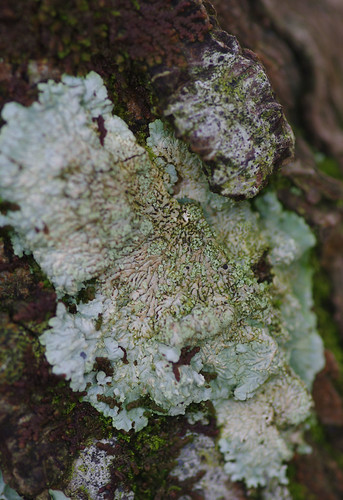
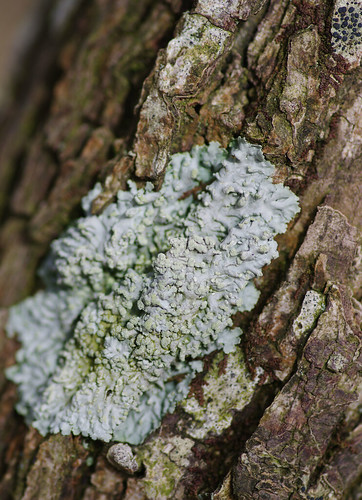
Two views of Diploicia canescens
Due to the high winds that often batter the headland, many of the trees were stunted and distorted in shape. But all forms of lichen life still found a home where they could.

Ramalina canariensis
We have not encountered (or at least not noticed) this species before. The lobes are wider, deeper and considerably more wrinkled underneath than those of Oakmoss.
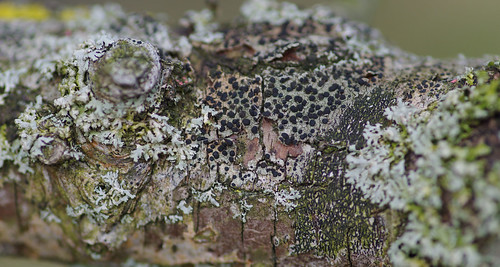
There are all sorts of species here. There's definitely a Physcia, as well as Lecidella elaeochroma near the centre of the image. Slightly to the right, the dense clusters of lines (some simple, some branched) belong to Opegrapha atra. You may also just be able to detect some tiny pink dots. They belong to Illosporiopsis christiansenii, a type of fungi which acts as a parasite on lichens. The first time I saw this near Broadsands Beach I assumed people had been graffiting branches with pink magic markers!
Having finished our cursory checks of every tree, we headed out to the Napoleonic fort. The narrow path goes over a ditch. There were narrow walls to each side. Some Caloplaca lichens looked so green and slimy they might actually be dissolving. Elsewhere, the walls were considerably drier and we began examining them to see what treasures could be found.
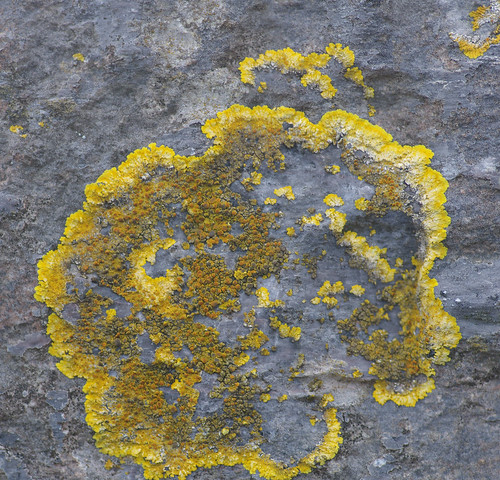
Caloplaca aurantia
This must be an older specimen because it has broken up in the centre. I wonder if there were lichens when soldiers were stationed here, watching the seas for signs of an invasion that never came. The lobes are more adpressed to the rock than Caloplaca flavescens.
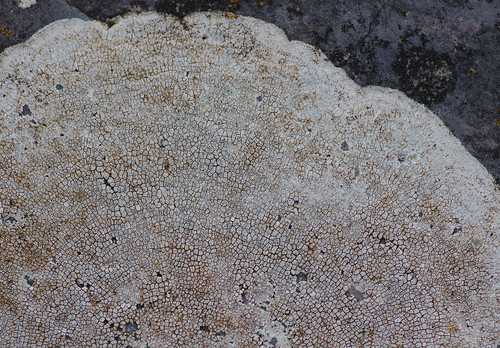
Aspicilia calcarea
There were lots of large, circular examples of this species growing on the limestone walls. The surface is cracked and can look like a mosaic.
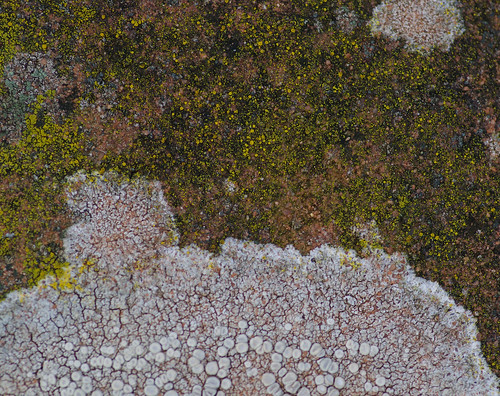
I was fairly certain that the scattered yellow bits would turn out be another type of Caloplaca lichen. That was before this image was processed and magnified. The black bits are actually not part of the rock as I had assumed but the thallus underlying the scattered yellow granules and apothecia. For that reason, I'm opting for Candelariella aurella.
Sherry then turned her attention to the white lichen below.
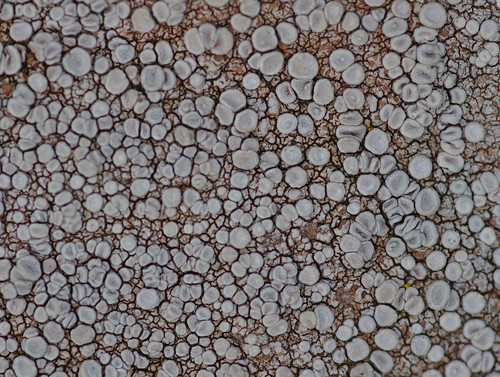
Close-up of Ochrolechia parella
Other names for this species include Crawfish Lichen and Crab's Eye Lichen.
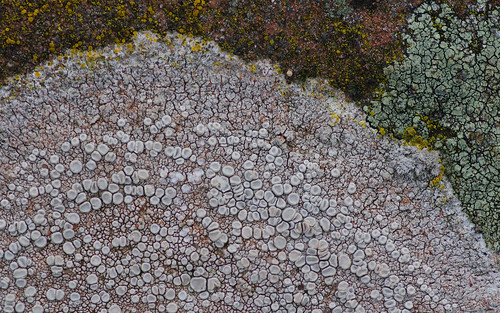
The green species on the right has posed another puzzle which cannot yet be pieced together. I think it looks consistent with a Verrucaria species. The question is: which one? It could be Verrucaria macrostoma, described as olive-green in the shade.
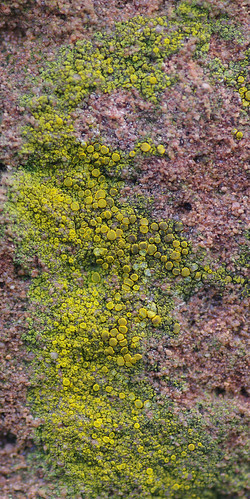
Probably one of the Caloplaca citrina group of species
But these also appear almost identical to a couple of the Candelariellas. Again, microscopic examination of the ascii, spores and chemical tests are needed to reach a conclusion.
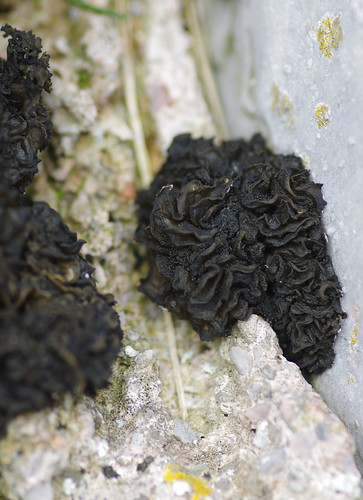
Collema auriforme
This one looked a bit like a dired seaweed. It is commonly found on limestone, both on the coast and inland.
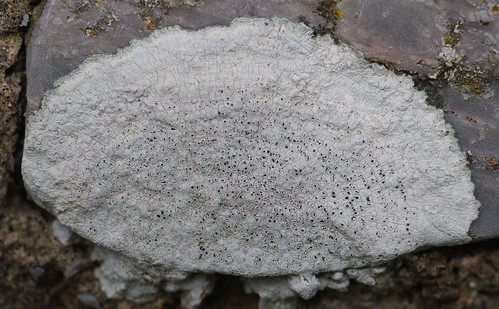
Another Aspicilia calcarea
This one looked much fresher than our first sample. I would never have thought that stone walls could invite such a number of different species.
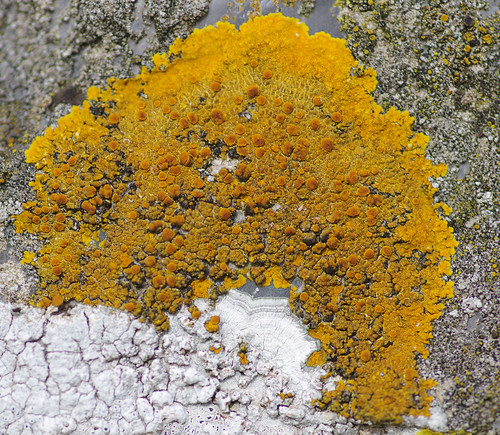
The previous species is cohabiting here with another Caloplaca aurantia. At length, we left the walls behind and headed for more trees.
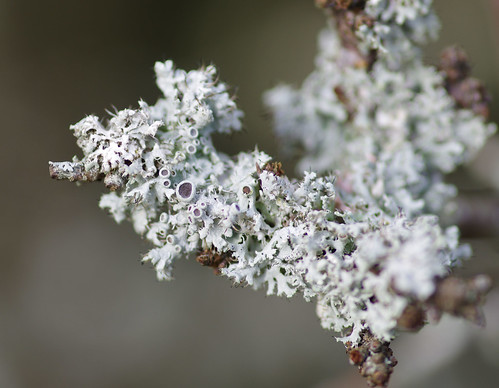
Physcia tenella
Thinking I had found a match to the cover of my lichen book, I got a bit carried away. It's always best to double-check. 'You see but you do not observe', as Sherlock Holmes might have admonished Dr Watson. The same holds true when trying to up the species count. Sometimes you see what you want to see and not what is right in front of you.
Physcia leptalea (on the cover of my book) has substantially longer cilia. It also lacks the black pycnidia present on the surface of Physcia tenella.
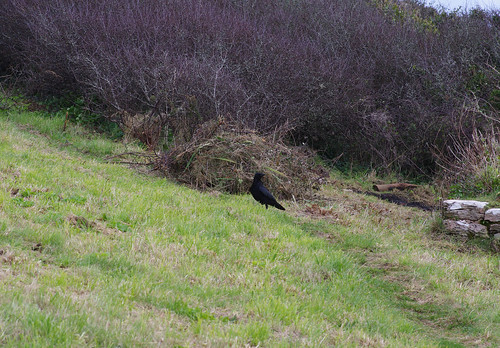
Carrion Crow (Corvus corone corone)
We had come through the trees and along a path. Crows are naturally curious but this one took such an interest I was starting to think it might follow us all the way home. But before we abandoned the hunt for new names, there were a couple more puzzles, ready to be discovered.

Xanthoria species

This is a young Ramalina
The branches are strap-like. We'll be going back to see how this one has grown and hopefully will also be able to confirm its identity.

Comments
Add a Comment